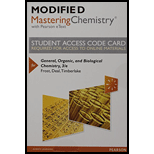
a.
To determine:
The classification of the reaction in which the reactants involved have lower energy than the products formed as being exergonic or endergonic in nature.
Concept Introduction:
b.
To determine:
The classification of the reaction in which the products formed have lower energy than the reactants involved as being exergonic or endergonic in nature.
Concept Introduction:
Thermodynamics is the branch of chemistry which studies the difference of heat and energies of product and reactant in the chemical reaction. Therefore, the sign of free energy change and heat change for a given chemical reaction is predicted by using the concept of thermodynamics.
Want to see the full answer?
Check out a sample textbook solution
Chapter 5 Solutions
Modified Mastering Chemistry with Pearson eText -- Standalone Access Card -- for General, Organic, and Biological Chemistry (3rd Edition)
- classify the following reactions a) addiction b) elimination c) replacement d) rearreglo e) combinationarrow_forwardwhy does Acetic acid increases the concentration of the reactant?arrow_forwardPertinent General Reactions. Bayer’s oxidation: Chomic acid oxidation: Lucas test: Ferric Chloride Test:arrow_forward
 Chemistry for Today: General, Organic, and Bioche...ChemistryISBN:9781305960060Author:Spencer L. Seager, Michael R. Slabaugh, Maren S. HansenPublisher:Cengage LearningChemistry: Matter and ChangeChemistryISBN:9780078746376Author:Dinah Zike, Laurel Dingrando, Nicholas Hainen, Cheryl WistromPublisher:Glencoe/McGraw-Hill School Pub Co
Chemistry for Today: General, Organic, and Bioche...ChemistryISBN:9781305960060Author:Spencer L. Seager, Michael R. Slabaugh, Maren S. HansenPublisher:Cengage LearningChemistry: Matter and ChangeChemistryISBN:9780078746376Author:Dinah Zike, Laurel Dingrando, Nicholas Hainen, Cheryl WistromPublisher:Glencoe/McGraw-Hill School Pub Co Chemistry In FocusChemistryISBN:9781305084476Author:Tro, Nivaldo J., Neu, Don.Publisher:Cengage Learning
Chemistry In FocusChemistryISBN:9781305084476Author:Tro, Nivaldo J., Neu, Don.Publisher:Cengage Learning Living By Chemistry: First Edition TextbookChemistryISBN:9781559539418Author:Angelica StacyPublisher:MAC HIGHER
Living By Chemistry: First Edition TextbookChemistryISBN:9781559539418Author:Angelica StacyPublisher:MAC HIGHER



